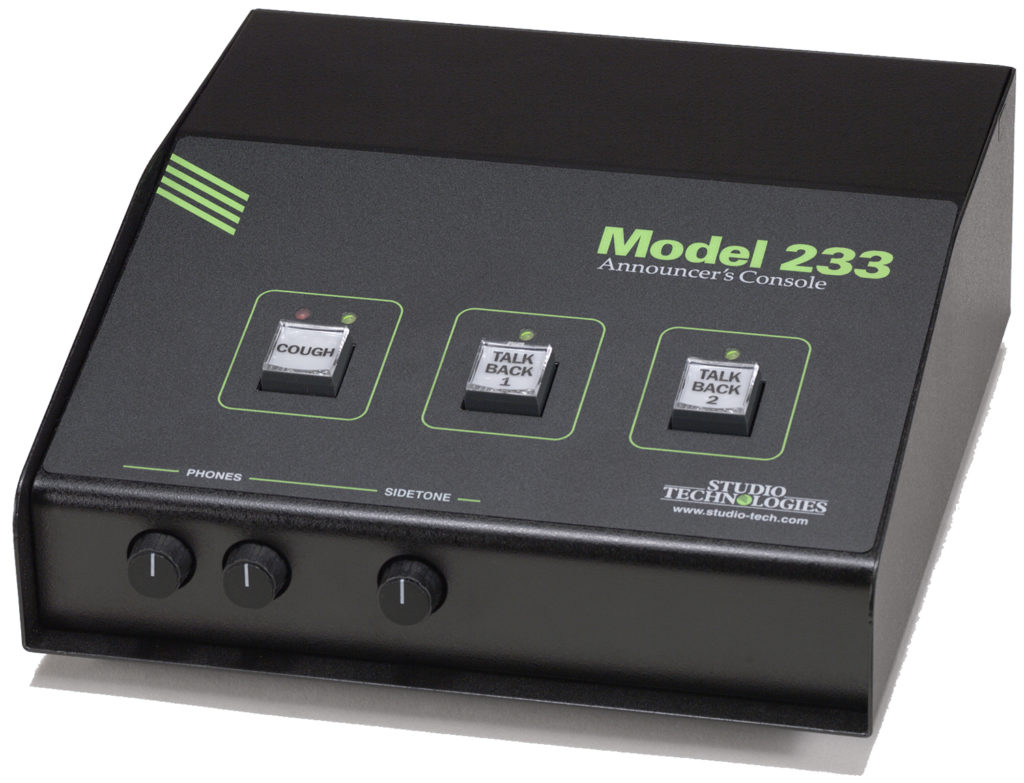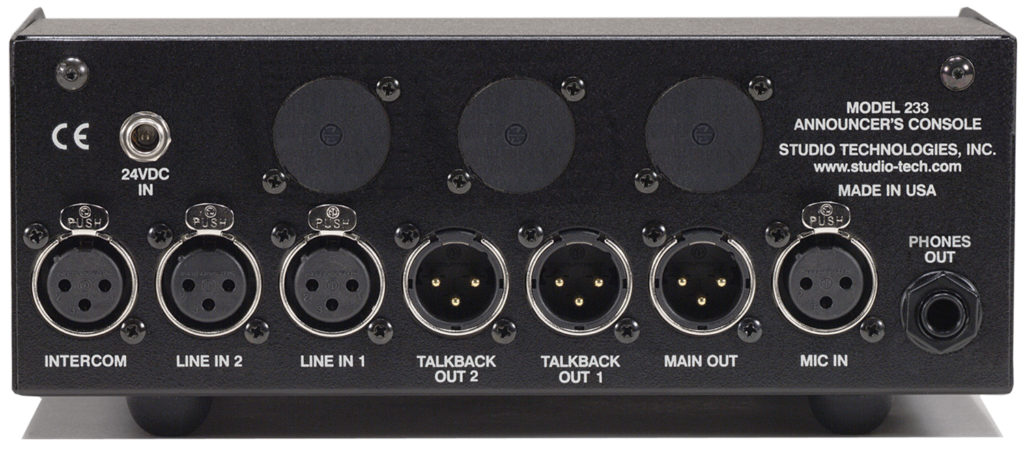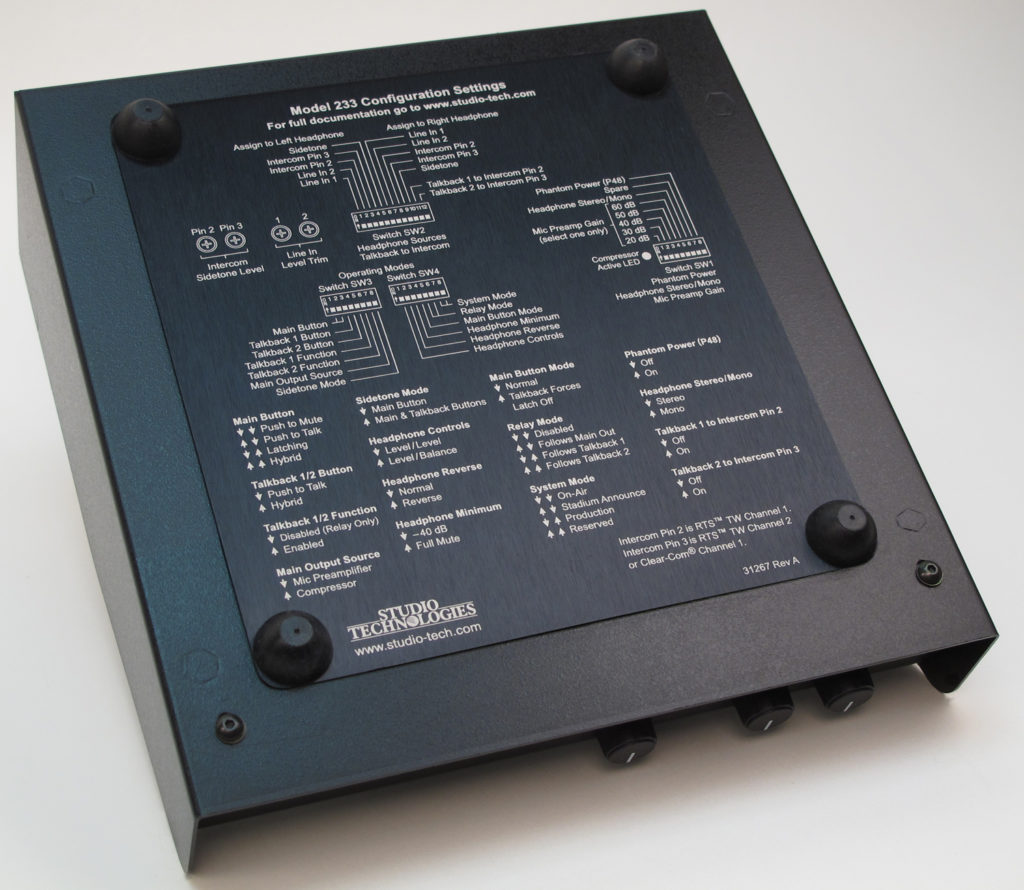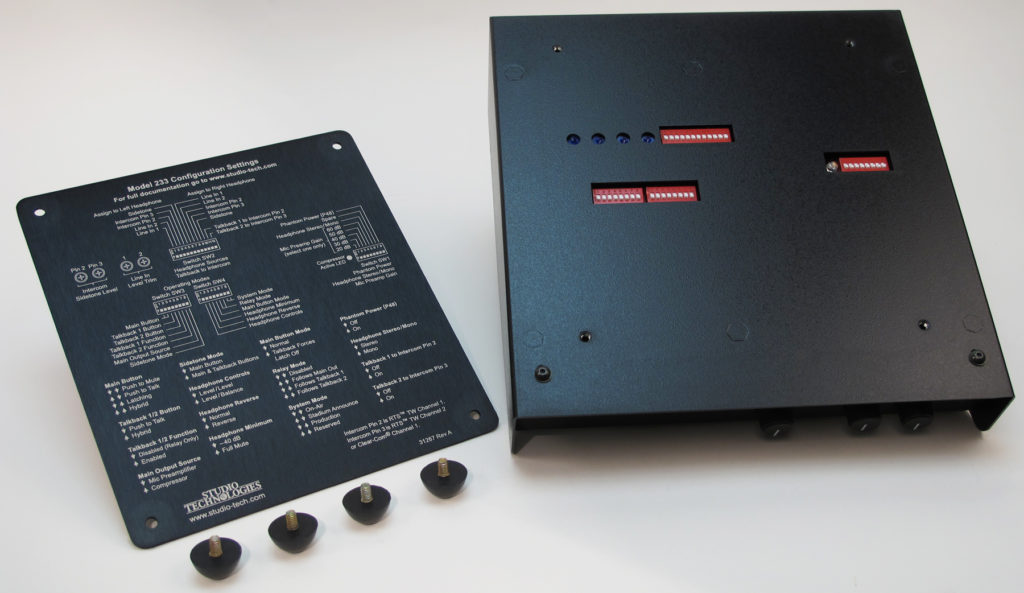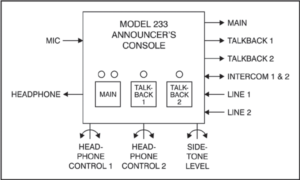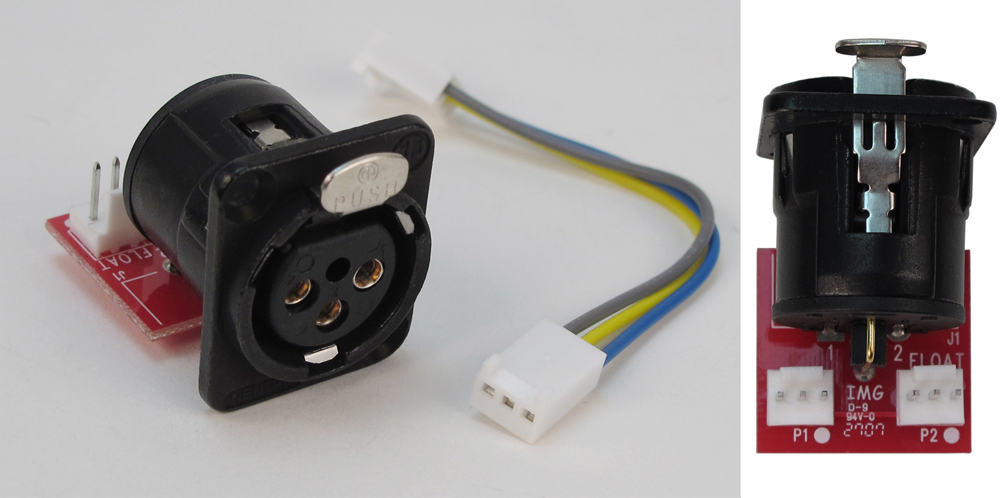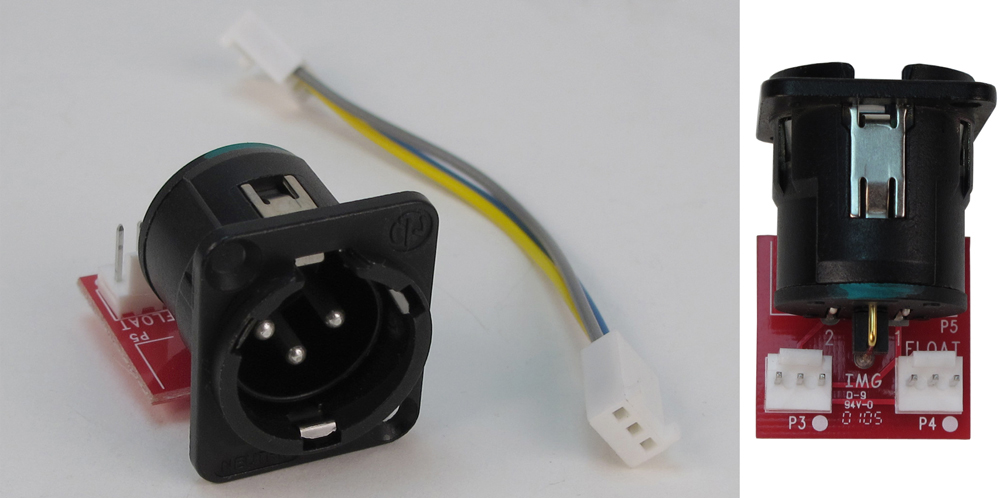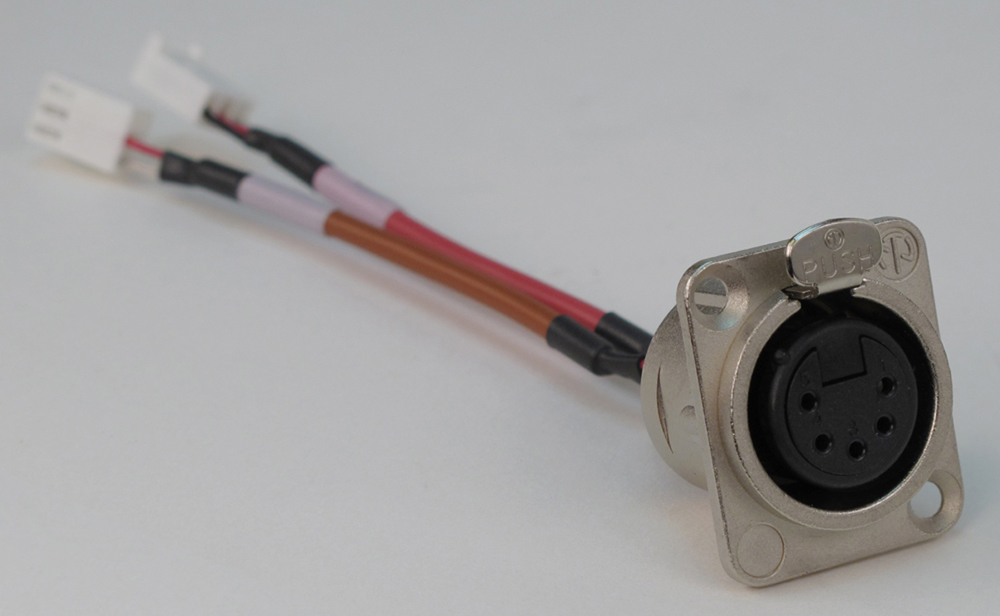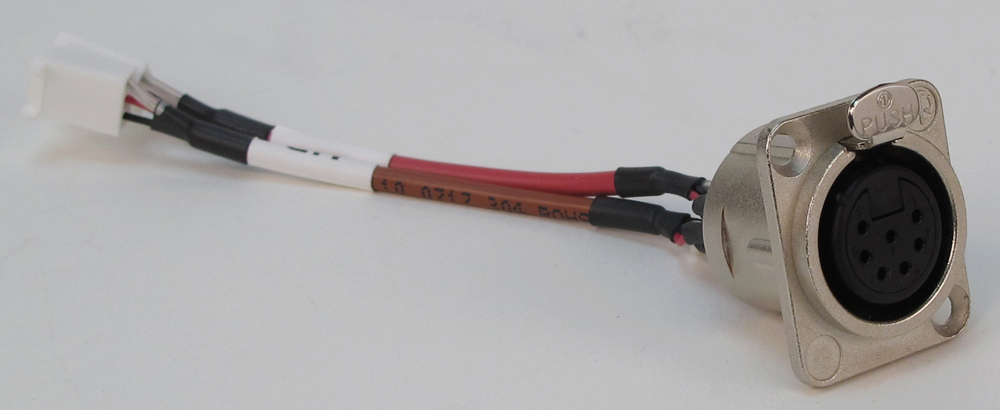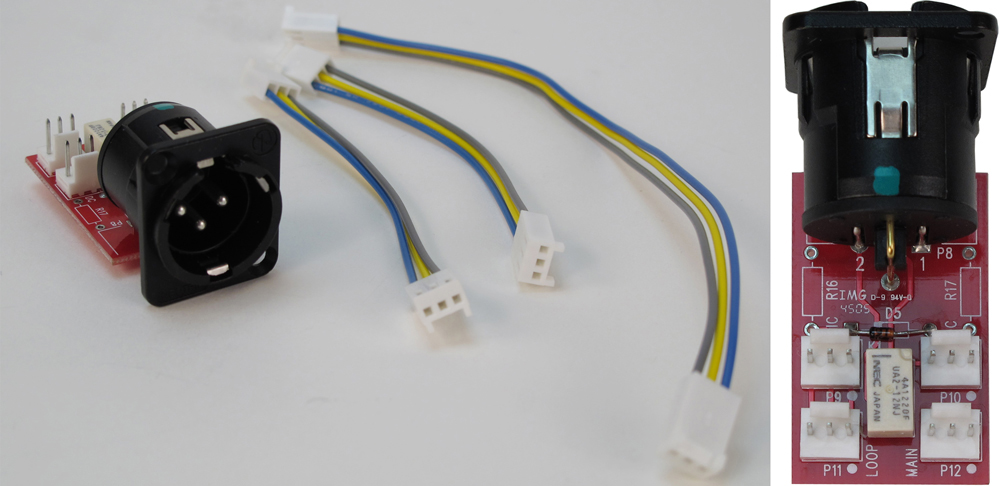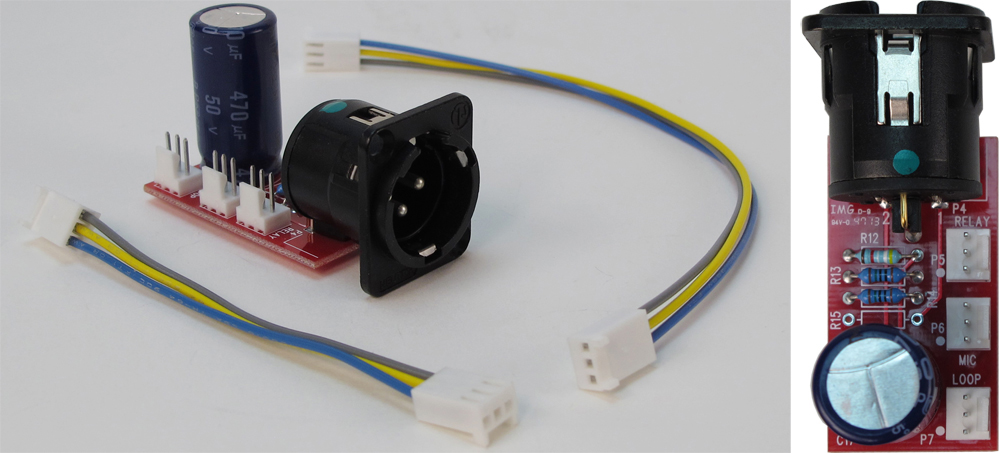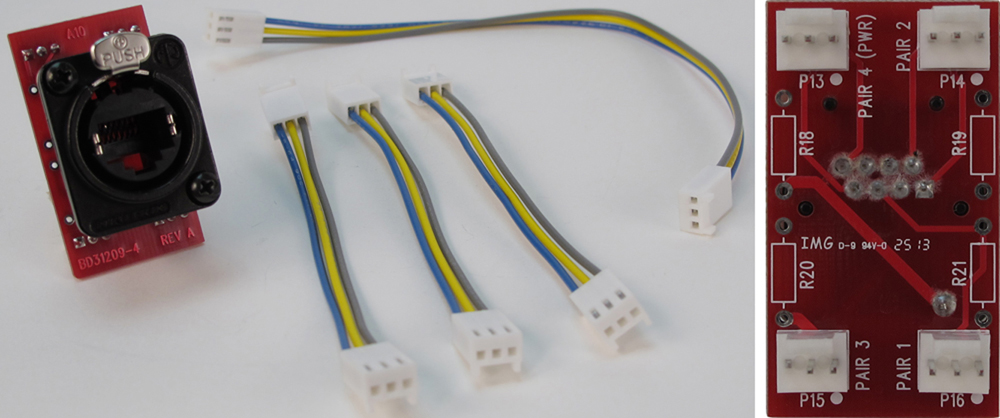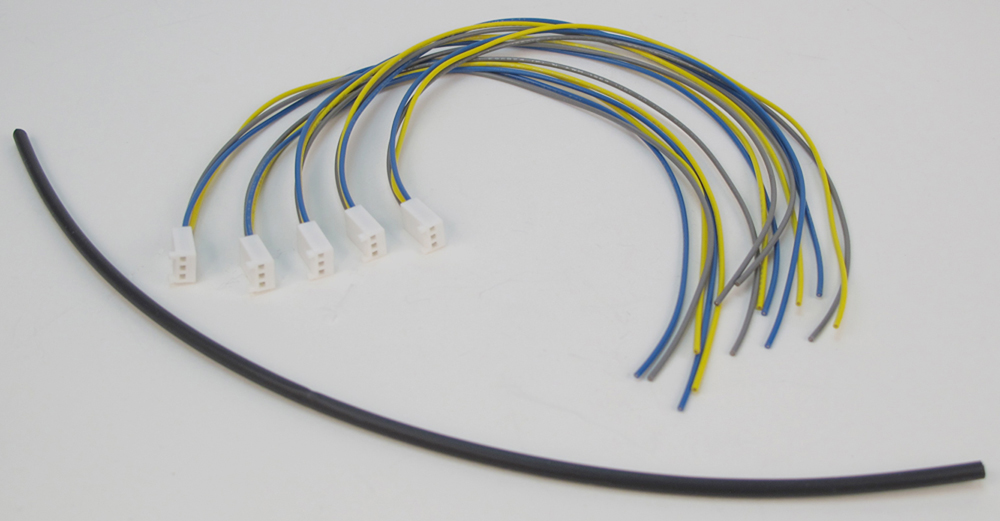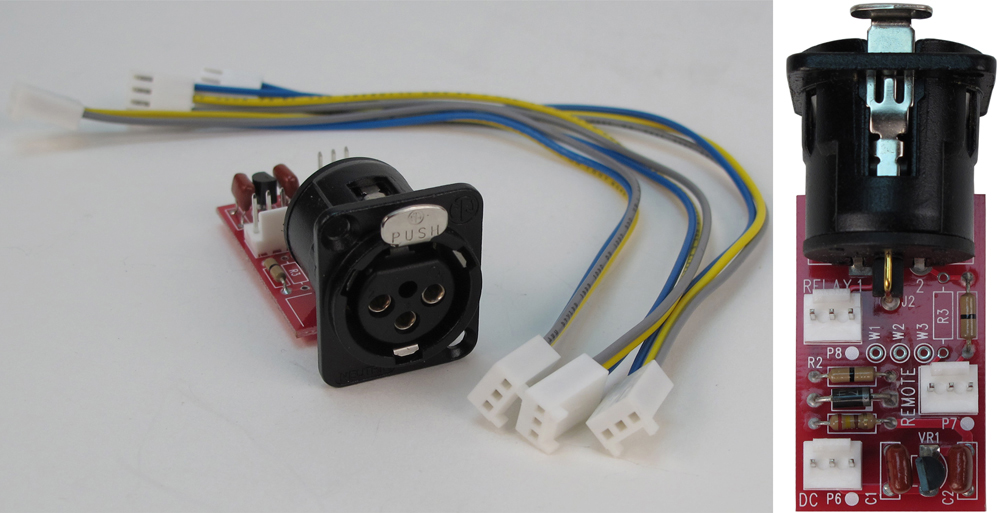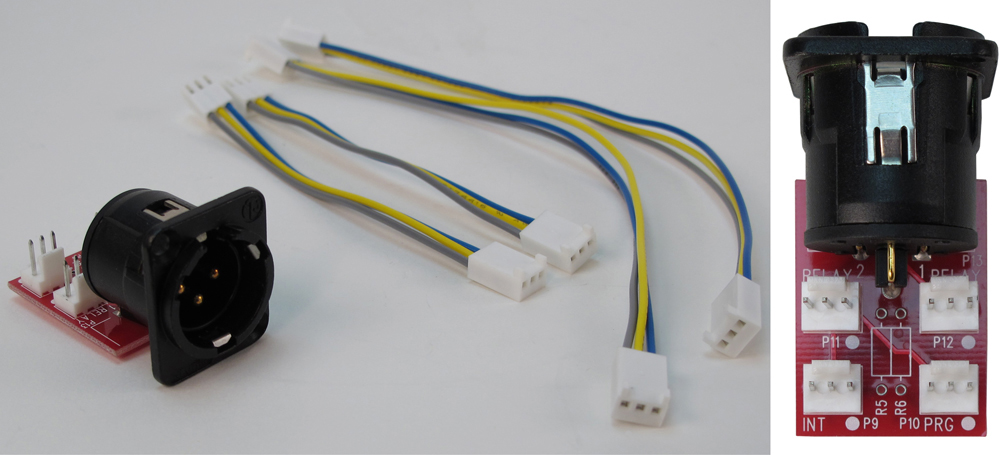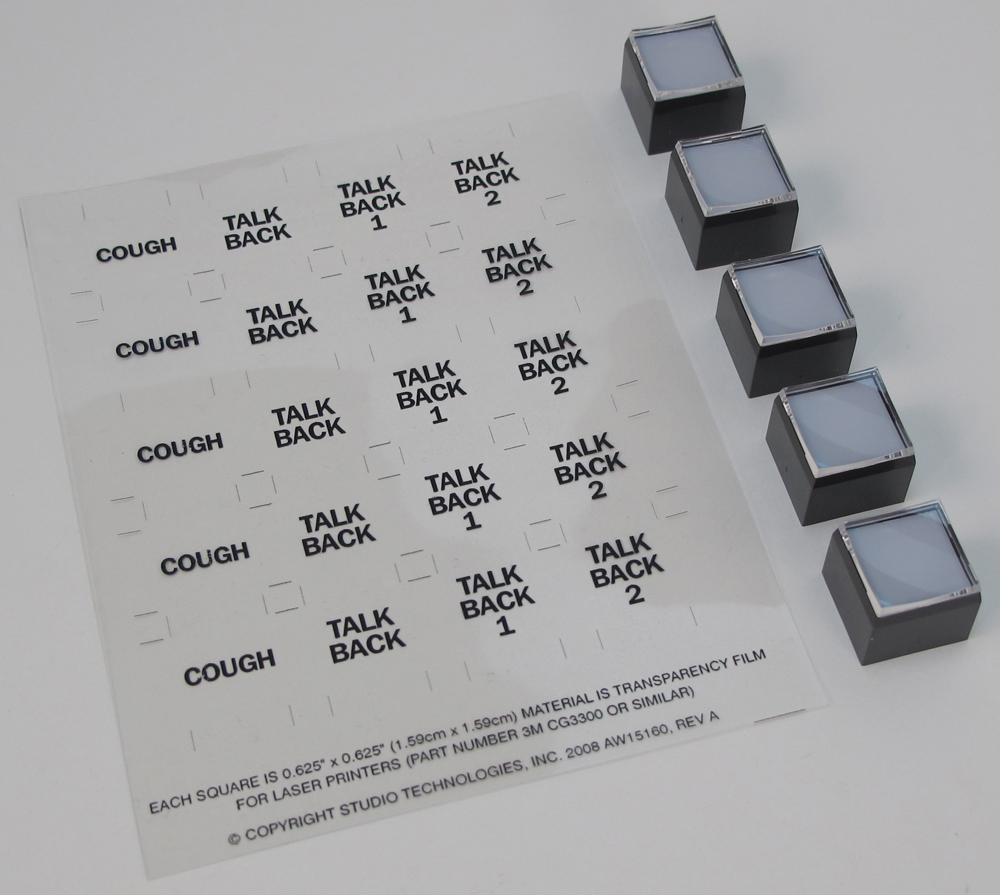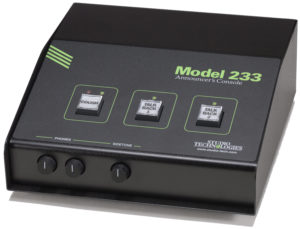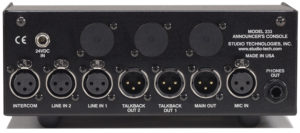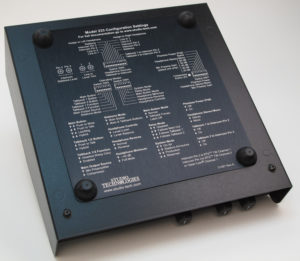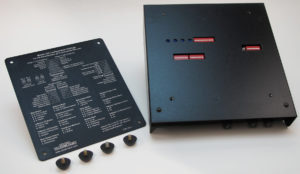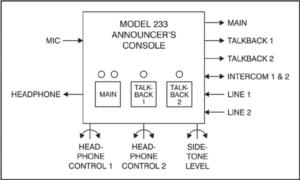Whether it's the mic preamplifier, audio switching, talkback signals, intercom interfacing, or headphone cue feed, superior audio quality is maintained throughout. A microprocessor provides the Model 233's logic power, allowing precise control of the unit's operation. With extensive flexibility built in, creating the desired operating configuration is a simple matter. While the operating features of the unit can be carefully tailored, the user is presented with an easy-to-use set of controls and indicators. A wide range of resources, great performance, and simplicity during use—these are the hallmarks of the Model 233.
The Model 233 is a truly "next-generation and then some" product. Exhaustive research into the needs and desires of field production personnel was integral to its creation. Providing a veritable "tool kit" of features, the unit supports a wide variety of applications that include on-air television and radio broadcasting, stadium announcement, and simultaneous interpretation. In addition, with the unit's broad range of capabilities many other specialized "behind-the-scenes" applications can also be implemented.
Microphone Input
A high-performance microphone preamplifier circuit provides low-noise/low-distortion amplification over a 20 to 60 dB gain range. The gain is adjustable in 10 dB steps. The input is compatible with balanced dynamic and condenser microphones. The microphone power source is 48 V nominal and meets the worldwide P48 phantom power standard. An LED indicator serves as an aid for optimizing the preamplifier's gain setting. The output of the microphone preamplifier is used by the main output as well as being routed to the compressor circuit that supports the talkback functions.
Main Output
The Model 233 provides a main output that is designed to serve as the on-air, stadium announcement, or other primary audio feed. Nominally –2 dBu, it is designed as a fully professional interface with high output capability, low distortion, and low noise. The output circuitry features a high-performance output transformer expressly designed for professional audio applications.
Talkback Functions
The talkback functions are intended to provide personnel associated with production trucks, control rooms, live-performance, and sports venues with talent-originated cue signals. The Model 233 contains two pushbutton switches that control the talkback functions. Associated with each pushbutton switch is a dedicated line-level talkback output. Each pushbutton switch can also be configured to send audio to one specific channel associated with the Model 233's dual-channel intercom interface.
The line-level talkback outputs are transformer-coupled with a +4 dBu nominal signal level. They contain resistors in series with the output connectors, allowing line-level talkback outputs from multiple units to be directly "summed."
For non-on-air applications, a special Model 233 feature set can be enabled by placing the unit in its "production" mode. This software-based mode allows the main output to be used as an additional talkback output. This feature makes the unit even more powerful when used in live-event applications, such as serving as a master console for an orchestra conductor or production director.
With all the available talkback flexibility, the exact needs of many specific applications can easily be met. And, of course, whatever configuration is implemented, the audio quality will be excellent.
Dynamic Range Control
To enhance the Model 233's talkback functions, a studio-quality compressor circuit is provided to control the dynamic range of the signal coming from the microphone preamplifier. Far from a simple "clipper," the circuit utilizes a sophisticated laser-trimmed voltage-controlled-amplifier (VCA) integrated circuit for quiet, low-distortion level control.
The signal from the compressor is always used by the talkback functions. For flexibility, the audio source for the main output can be selected to be either the direct output of the microphone preamplifier or the output of the compressor. For on-air applications the signal coming directly from the microphone preamp would be correct. But having dynamic range control of the signal going to the main output can offer increased performance for selected applications. These could include stadium announcement locations, award show conductor positions, and use with non-professional announcers during sports events.
User Controls and Status Indicators
Three pushbutton switches, four LED indicators, and three rotary controls provide users with a clear, easy-to-use interface. One pushbutton switch controls the status of the main output. This is the audio output intended for on-air, stadium announcement, or other primary uses. Two LEDs display the on/off status of the main output. Two additional pushbutton switches control the status of the talkback functions. These are the audio cue signals used to communicate with producers, directors, "spotters," or other behind-the-scenes production personnel. A status LED is associated with each talkback button. Three rotary controls allow the user to adjust the level of the headphone output. Two of the controls are associated with externally connected cue signals. The third control is associated with the Model 233's sidetone function, allowing the user to monitor the signal associated with the unit's microphone input.
Flexibility
A large part of the Model 233's unique power is the ability to configure the operation of the main output and talkback functions. To meet the needs of the many specific broadcast and production applications, a variety of button operating modes is available. The main output button can be selected to operate from among four modes. In the "push-to-mute" mode the button performs a momentary mute of the main output. In this way a "cough" button function is created, something typically required for television sports broadcasting. In the "push-to-talk" mode the button provides a momentary active function for the main output. This mode would be appropriate for applications such as stadium announcement. An alternate action "latching" configuration allows the button to enable or disable the main output as desired. This is useful in radio broadcasting, announce-booth, or voice-over applications. The fourth mode provides a hybrid function, supporting both push-to-talk and tap-to-enable/tap-to-disable operation. This operation is similar to that found in many broadcast intercom system user stations.
The two buttons associated with the talkback functions can be configured to operate from either of two modes. One of the modes supports a "push-to-talk" function. This is typically used for on-air broadcast applications. The other mode provides a hybrid function, the operation of which is discussed in the previous paragraph. The hybrid mode is especially useful when the Model 233 is used in a production-support application.
The main button mode configures how the main output, when it is in the "latched" on state, responds to talkback activity. One choice momentarily turns off the main output when talkback is active, returning the main output to the on state when the talkback function has ended. The other choice "unlatches" the main output in response to a talkback function.
Cue Sources
The Model 233 supports the connection of up to four external audio sources, each of which can be selected for routing to the stereo headphone output. The sources are line input 1, line input 2, intercom channel 1, and intercom channel 2. Each source can be individually assigned to the left channel, the right channel, or both the left and right channels. This allows a wide variety of stereo and mono headphone mixes to be created.
For application flexibility, two line-level audio sources can be connected to the Model 233. Possible signal sources include off-air receivers, wireless IFB systems, and audio consoles. The connected signals can be from two independent sources, or could be from a stereo audio feed such as would be associated with a broadcast music event. Two level trim potentiometers, located on the bottom of the unit, allow signals with wide nominal audio levels to be cleanly interfaced. Audio signals associated with a single- or dual-channel intercom system can be routed to the headphone output. The Model 233's intercom interface is compatible with standard party-line intercom systems from manufacturers such as RTS® and Clear-Com®. A broadcast-type IFB (interrupted foldback) circuit can also be connected to the intercom input. This "listen only" signal is often found in television broadcast applications. Sidetone
The Model 233 includes an integrated sidetone function that allows the output of the compressor circuit associated with the microphone preamplifier to be routed to the stereo headphone output. This provides a confidence signal to the user, allowing them to hear exactly what is being sent to the main and, if desired, talkback outputs. This sidetone signal can be a critical element when creating an effective communications environment.
In on-air television and radio broadcast settings the Model 233 user's own microphone audio signal is typically returned to the headphone output by way of a cue audio source. But there are cases where this signal is not available, such as when "mix minus" cue feeds are utilized. This type of cue feed includes everything but the user audio, a requirement when significant time delays, typically associated with satellite transmission systems, are present. In effect the Model 233's sidetone function adds the "minus" part to a "mix minus" cue.
Several configurable parameters allow the sidetone function to be tailored to the needs of a specific Model 233 installation. The sidetone function can be configured to route audio to the left, right, or left and right headphone outputs. It can also be completely disabled. Sidetone can also be configured to be active only when the main output is active, or to be active anytime the main output or either of the talkback outputs is active.
Headphone Output
Three rotary controls are provided for user adjustment of the headphone output. Two of the controls adjust the levels of the externally connected sources. The third control is used to set the level of the side-tone function. For flexibility the actual functioning of the two controls associated with the external sources is configurable. For traditional on-air sports applications they can be selected to the dual level control mode which provides independent control of the left and right channel volume. For use with stereo cue signals, or to support user preference, the level/balance mode can be selected. In this mode one control adjusts the overall level of both the left and right channels, while the other allows adjustment of the left/right level balance. To help minimize the chance of broadcast cues being missed, both level control modes can be configured so that a minimum headphone output level is maintained. Alternately, the headphone output can be set to fully mute when these controls are at their minimum position.
A headphone control reverse mode is provided specifically for on-air television applications where a headset with boom microphone is used. The reverse mode ensures that no matter which headset orientation is used by the talent, the two "pots" controlling the external sources will always work intuitively. This will result in a comfortable work environment, allowing the "left" control to impact the level to the talent's left ear while the "right" control impacts the right.
The sidetone level control is dedicated to adjusting the level of the mic audio signal that's routed to the headphone outputs. Configuration switches allow which of the headphone outputs—left, right, or both—will receive the sidetone signal. When the sidetone level control is set to its minimum position the sidetone level is always set to be fully muted. Provision has been made to support applications where a monaural cue feed is desired. A configuration switch allows the summing (combining) of the selected left and right headphone sources. In addition to creating a dual-channel mono output it also allows the level controls to be configured as a simple 3-channel mixer.
The headphone output is optimized to meet the needs of contemporary headphones and headsets. Specifically, the output circuits act as voltage, rather than power, drivers. In this configuration they can provide high output levels with very low distortion and noise, along with minimal current consumption. The output circuits are configured to safely drive stereo or mono loads. This ensures that all types of headphones, headsets, and earpieces can be directly connected.
Intercom Interface
Of special note is the Model 233's sophisticated intercom interface. It's designed to work correctly with industry-standard single- and dual-channel party-line intercom systems, including those from RTS and Clear-Com. An intercom line connected to the Model 233 can serve three functions: providing cue audio signals to the headphone output, allowing talkback audio to be sent to intercom users, and acting as a Model 233 power source. Audio signals present on the single- or dual-channel intercom line can be flexibly routed to the stereo headphone output. Talkback audio, controlled by the two talkback pushbutton switches, can be sent to either or both of the intercom channels. Trim potentiometers, located on the bottom of the unit, allow adjustment of the talkback-to-intercom sidetone (null) level.
Other announcer console products can exhibit talkback-to-intercom-related audio oscillations ("squeals") that end up in the headphone output. A unique Model 233 feature ensures that this will never occur. This is accomplished by means of a special "auto-terminate" circuit that becomes active whenever an intercom line is not connected to the Model 233.
Audio Quality and Protection
The Model 233's circuitry is carefully tailored to provide excellent audio performance. Professional-quality components are featured throughout. For reliability all audio routing is performed using solid-state devices under microcontroller direction. In all critical audio paths, "clickless" electronic switches provide noise-free control. All audio inputs and outputs make extensive use of protection components. This limits the chance of damage from ESD and other undesirable, yet real-world, hazards.
Power Sources
The Model 233 can derive its operating power from an intercom line or an external 24 Vdc source. For redundancy, both power sources can be connected simultaneously. An internal switch-mode power supply ensures that all Model 233 features are available, including phantom power, when the unit is powered by either source.
Auxiliary Relay
Model 233 resources include a general-purpose relay, allowing specialized configurations to be created. Under software control, the relay can be configured to follow the state of the main output, talkback 1, or talkback 2 buttons. Taking advantage of the back-panel locations provided for additional XLR connectors, a technician may easily create functions such as an "on-air" indicator or implement loudspeaker muting during talkback function. Special configuration modes are even included to allow direct control of the relay using the talkback 1 or talkback 2 buttons without impacting any of the Model 233's audio signals.
Tally Output
Another unique Model 233 feature is the tally output. It provides an indication, in the form of a current-limited DC signal, of the status of the main output. Whenever the main output is active the tally output is active. This 3.5 V nominal, 12 milliamperes (mA) maximum, signal is capable of directly lighting an LED indicator or triggering an external control system. The tally output is provided specifically for specialized applications such as television award show broadcasts where remote monitoring and control of the main output is required.
Configuration
Model 233 configurations are made using a number of DIP switches and four trim potentiometers. One 8-position switch assembly is used to set the gain of the microphone preamplifier, the on/off status of phantom power, and control of the headphone output mode. A 12-position switch assembly configures which of the four cue audio sources, as well as the sidetone audio, are routed to the headphone outputs. In addition, the last two sections of the 12-position switch assembly are used to select whether talkback audio will be routed to the intercom interface. Two 8-position switch assemblies communicate the desired operating modes to the microprocessor.
Two rotary "trim pots" are used to adjust the sensitivity of the line inputs. Two additional rotary trim pots are provided to adjust the sidetone (null) level for the intercom interface's talkback functions.
All switches and trim pots are accessible via the bottom of the Model 233's enclosure; the unit does not have to be disassembled. Changes made to any of the configuration parameters become active immediately. To prevent access to the configuration controls a security plate, included with each unit, is attached to the bottom of the enclosure.
Connectors
The Model 233 uses standard connectors throughout. The microphone input, line inputs, and intercom interface functions use 3-pin female XLR connectors. The main and line-level talkback output functions use 3-pin male XLR connectors. The headphone output utilizes a ¼-inch 3-conductor jack. The external source of 24 Vdc power is connected by way of a 2.1 x 5.5 mm "locking" coaxial power jack.
Additional Connector Locations
In the world of broadcast, production, and public address audio it's fair to say that applications vary widely. To this end, up to three additional XLR connectors can be easily mounted into the Model 233's back panel. Multiple 3-position "headers" located on the Model 233's circuit board provide technician-access to literally every input and output connection. Moreover, some additional features, including the remote control inputs and tally output, are accessible using 3-position headers. Using a factory-available interface cable kit, these headers allow a Model 233 to be optimized to meet the exact needs of specific applications. For example, some applications may prefer to use a multi-pin XLR connector to interface with a headset. This could be easily accomplished by adding the appropriate 5-, 6-, or 7-pin XLR connector and making a few simple connections. Other applications may benefit from having "mult" or "loop-through" connections, something easily incorporated into a Model 233.
Multi-Pin Headset Connectors
As previously mentioned, some applications are best supported using headsets that interface using a multi-pin connector. In most of these cases the desired connectors are 5-, 6-, or 7-pin male XLRs wired to an industry-standard pinout scheme. Studio Technologies offers headset connector assemblies that allow fast and painless installation into a spare connector location in the Model 233's back panel.
Options
The Model 233's standard resources are more than sufficient to directly support a large number of applications. But in the "real world" of audio and intercommunications special needs always seem to arise. To that end, Studio Technologies offers a number of option cards. In addition to passive or active components, each card contains an integral connector, allowing simple installation into a spare connector location on the Model 233's back panel. For interest, the resources provided by some of these option cards are worth describing.
- The direct microphone output card provides access to the dynamic or condenser microphone that is connected to the Model 233's mic input. Passive components, along with the auxiliary relay contact, create a "click-free" microphone-level audio signal.
- The remote switch input card uses a 4-pin XLR connector to provide access to the Model 233's remote switch inputs.
Other general-purpose option cards provide 3-pin XLR, 4-pin XLR, and 8-pin EtherCon® connectors. With the range of option cards available it's hard to imagine an application that can't be served. But you're welcome to try to "stump the chumps" in the Studio Technologies technical support department! But first please check the complete list of the available option cards.

